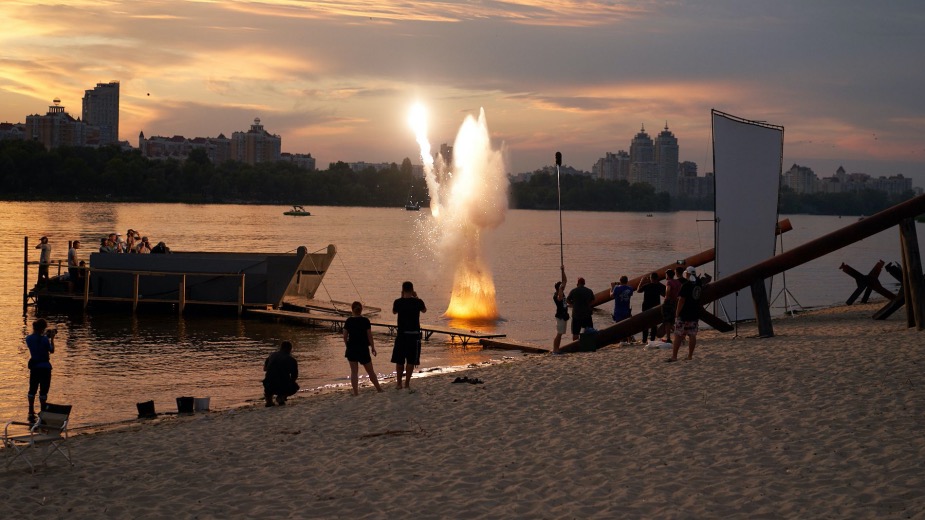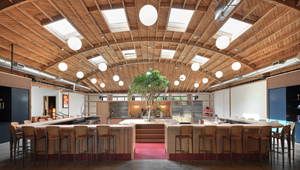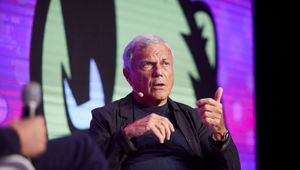
Virtual Insanity as Ian Pons Jewell Enters the World of Oculus

As Covid continues to keep many of us stuck in our homes, the appeal of escaping into a virtual world only grows stronger. And so, Ian Pons Jewell’s recent Oculus ad, which whisks us to a galaxy far, far away and beyond couldn’t feel more relevant right now. And after a year of fairly small, Zoom-call-recorded ads, this ambitious, world-hopping point of view adventure feels pretty liberating.
The spot was created between the in-house creative team at Facebook/Oculus (Robbin Ingvarsson and Kako Mendez) and an agency team at TBWA\Chiat\Day New York. It’s an experience that Ian describes as ‘beyond perfect’, with no politics getting in the way of collaboration. And that’s not just Ian praising clients – he says that the smoothness and pleasure of the project really stood out from other direct-to-client experiences.
Oculus - First Steps from Ian Pons Jewell on Vimeo.
“It had some semblance of a traditional commercial with a client and agency, but the client is actually the creative as well. There was absolutely zero beef or problems or conflicts or anything. It was incredible. For something that massive, it was really, really smooth running in all departments,” says Ian.
The film was produced by RESET and producer Jon Adams, with service production from Radioaktive Film. The shoot took place in Ukraine – being a consummate creative problem solver, Ian, had decided to base himself in the country over the summer in order to keep working, shoot any upcoming projects there and avoid the risk of changing border controls
“Radioaktive are like family now really; Ukraine is a second home. It was Darko who suggested I go out there for a few months. I was meant to be writing a feature last year and it all got put on ice due to some rights issues. I was left without the film to work on, so I started developing other film projects slowly. I decided to be sensible and thought I could shoot, but I didn’t really want to be travelling around all over the place,” says Ian.
From a creative and production point of view, there was plenty for Ian and the team to get stuck into, even aside from working within Covid-19 safety measures and restrictions. One of the big challenges Ian faced was translating the experience of virtual reality to film. He notes that when it comes to point of view-style filmmaking, audiences are used to either frenetic handheld cameras or the distinctively non-cinematic scale of shows like Peep Show. However, says Ian, that’s not quite how we experience the world – virtual or real.
“Handheld has kind of engrained itself in cinematic language to mean “point of view” – but you don't see things wobbly,” says Ian. “Even if you're running, your eyes are the most advanced gimbal on the planet in that they adjust constantly as you bounce up and down. Your eyesight is the most incredible bit of tech that there is. I wanted to be representative of real point of view eyesight, which is really weirdly smooth and like laser-like.”

One of the distinctive aspects of point of view filmmaking and virtual reality is to give the impression that the camera is attached to a body. That meant that Ian had to figure out how to create that illusion and place arms into the film. In order to do that, Ian turned to a surprisingly low tech solution – he cast twins to play each arm.
“I was looking at doing CG arms, so that the camera could move. I thought I could use a proper camera on dolly or steadicam and then just put the arms in post by shooting them separately. And then after I did the choreography, I realised I’m never seeing the body apart from the arms, so I thought if I just cast two different people to play the arms then I can just stick them next to the camera. This technique avoided rigging a shitty camera to a helmet and relying on the actor as a camera operator” says Ian.

Twins, it turned out, were the ideal solution because even though we might assume one hand is pretty much like another, they’re actually pretty unique. Of course, he couldn’t just cast any twins, but twins who could handle complex choreography – so he worked with Kharmel Cochrane to find the acting, dancing Jaiy twins.
“Twins can have an interconnectedness that others don’t and it was really needed due to the strange requirements. In the casting, I just had them open up a zipped rucksack. It sounds simple, but if the two hands aren’t working together to mimic one person, it looks really odd and gives away the game. So, it needed constant teamwork between them so twins just felt like the right path to go down.”

When you watch the film, the sheer variety of scenes and styles gives the impression of a very complex production. And it was – there were multiple set ups, elaborate sets and production design, a huge cast, and a range of techniques. The team would be forgiven had the shoot dragged on – but says Ian, the upfront organisation and the efficiency of the team meant that there was no need to go into overtime. Plus, most of the set-ups were one-shot scenes that didn’t need extra coverage. Before the shoot itself, Ian together with DP Mauro Chiarello and 1st AD James Dyer created a shot-for-shot ‘crap-o-matic’ film. The gang found themselves running round a public park in Kiev with toy AK-47s, figuring out shots using a smartphone camera. Ian operated and played the right hand, whilst Mauro played the left. And it was that sort of planning and prep that allowed the team to crack on when it came to the shoot.
Ironically, perhaps, the longest day was spent on the most deceptively ‘simple’ part of the film: the scene set outside of the Oculus world. “The apartment was a set build because most of the locations the team saw were just too small for a camera operator, with a gimbal, and two actors either side to pass through doors.”

As we jump from scene to scene, it’s clear that every set up has some creative flourish or twist that makes it special for Ian. The Jurassic World scene was shot using a blacklight effect that he and Mauro first experimented with in a never-released Kanye West video. It takes its inspiration directly from a level in the Jurassic World Aftermath game in which the player must hide from velociraptors in a lab. It was recreated in-camera, with shadows painted in black and the set lit in a flat 2D way.

“The zombie one was the best set, full build, the whole thing. The zombies are real, apart from the large zombie crows outside. Robin Brown knocked it out of the park as usual. And then the craziest one is probably where they land at Normandy. That’s just a river with sandy beaches. While we were filming, people were just suntanning on the riverbank,” recalls Ian.

These sunbathers were, of course, removed and textures and other background elements built up. Indeed, creating the fantastical virtual worlds of Oculus inevitably required a whole lot of visual effects – so Ian worked with the Mill London. He’s full of praise for the team led by CD Dan Williams, EP Alex Fitzgerald and VFX Supervisor Adam Droy – who of course had to weave their magic while also dealing with the challenges of remote working.

“They were collaborators from day one and we were constantly talking all the time. It’s all about planning, planning, planning and I’ve got a good handle on post. And they had brilliant ideas for work arounds for different problems,” says Ian. For example, during the zombie scene the team were finding timing around the movement of pulling an axe from the rucksack hard to nail, so they decided to shoot the arms separately and composite them in afterwards for that scene.

The experience of making the film has got Ian thinking about the storytelling possibilities of interactive media. “I would love to do some work in the video game world, it’s just another narrative medium and I think we’re a bit behind about the possibilities, honestly, in our industry and the production company advertising bubble. Now having seen how good the VR is, it’s definitely something in my mind,” says Ian. As a director known for his mind-bending (and occasionally mind-melting) creativity, it’s an exciting prospect.

But being a thoughtful kind of chap, Ian’s fairly ambivalent in his thoughts about the potential impact of VR. It’s got enormous creative potential and is a welcome escape, but he’s wary of the normalisation of disconnection or the promotion of human connection mediated by technology along.

“We’re headed for total immersion and much sooner than we think,” he says. And given his affinity with Ukraine, he has a surprisingly local analogy. “Coronavirus is basically the Chernobyl of today. Chernobyl marked the end of a totalitarian system… Gorbachev credits that disaster as the true reason for the Soviet Union’s collapse. I think the coronavirus pandemic is another disaster that is bringing about the rapid advance into a technocracy and a technological separation. Normalising disconnection and using technology to stay connected.”
He’s keenly aware of the irony, given he’s just completed an ad for virtual reality. VR, he figures, is an inevitability – but if we can as a society can cherish the importance of human connection, there’s hope that we can nudge the inexorable march of progress and technology to a positive place.















